Chameleons are some of the most iconic reptiles in the world.
This family of lizards is famous for their beautiful colors and ability to change hue.
Despite their popularity there is a lot of misinformation on how to care for a baby chameleon. Babies stress easily, are not domesticated and have specific diet and housing requirements.
Caring for a baby chameleon is difficult and not recommended for beginners.
If you are looking to adopt this species then read this article first to learn how to take care of them.
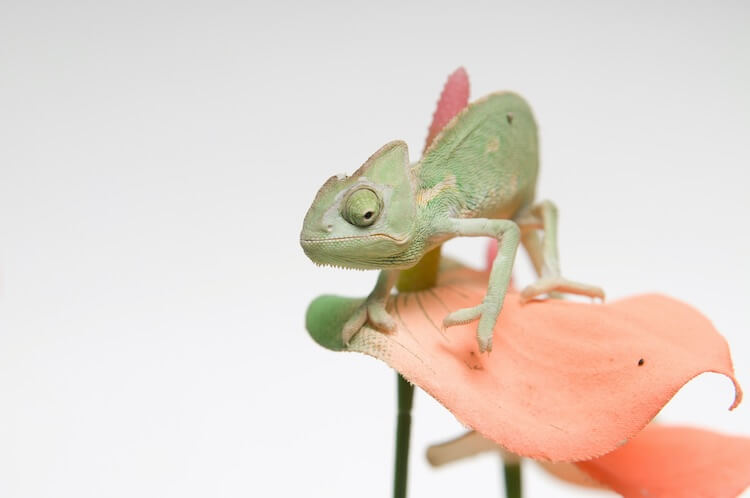
What Is A Baby Chameleon Called?
When a Chameleon is first born they are called hatchlings. They are only considered hatchlings for the first 24 to 48 hours as they hatch from their egg.
After their first 48 hours they are simply called “Chameleons” and not baby Chameleons!
The term Chameleon does not refer to a specific species but is an umbrella term for a family of lizards.
Chamaeleonidae are a unique group of arboreal lizards that live in tropical and warm climates.
There are more than 100 subspecies worldwide that fall under this umbrella term. Some of the most popular species are the colorful panther chameleon and the vibrantly colored green veiled species.
Do Baby Chameleons Make Good Pets?
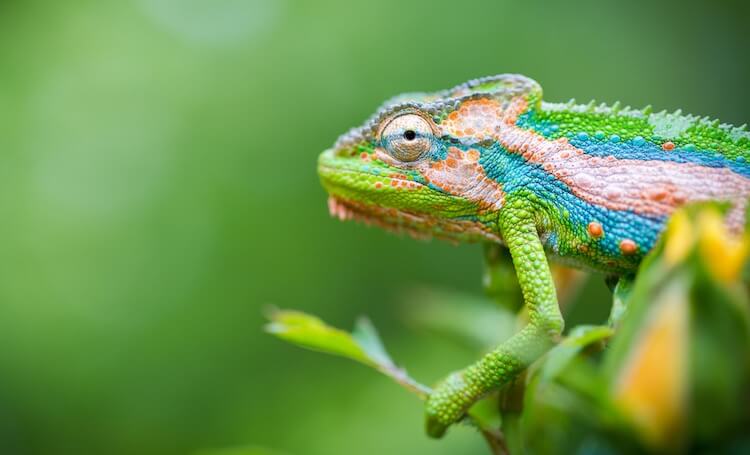
Chameleons are popular pet reptiles. They have beautiful colors and unique physical characteristics such as their ornate crests and prehensile tails.
Even though adults are fascinating pets, Baby Chameleons are not recommended for inexperienced keepers.
Taking care of this species takes a lot of work – especially when compared to other lizard species such as leopard geckos, skinks and bearded dragons.
They need very specific amounts of vitamin A, D and UV light. In order to provide them with the correct amount of each vitamin you will need to feed them a pre-formed vitamin.
You will also need to make sure you are feeding them a correct diet. Food in captivity is often less nutrient dense than in the wild that can lead to nutritional metabolic bone disease.
Finally, you will need to provide your lizard with a proper UV lighting fixture and habitat. They are extremely sensitive to nutritional or environmental changes and stress very easily.
If you decide to buy a Baby Chameleon it is not uncommon for them to die during shipping. This is due to the stress they undergo during transit.
You should also avoid handling him as much as possible. This species is not domesticated and does not like to be handled.
Repeatedly touching young Chameleons will likely lead to premature death.
How Much Does A Baby Chameleon Cost?
There are over 100 subspecies of Chameleon. The price of a baby Chameleon depends on their subspecies. Many species can be purchased for $30 to $100. However rare individuals such as the Veiled species can cost $400.
Males are generally hardier and have more vibrant colors. This makes them more expensive than females.
Here is a list of some species sold in the United States and their price range:
| Species | Price (USD) |
|---|---|
| Elliot’s | $30 to $90 |
| Dwarf Fisher’s | $30 to $90 |
| Jackson’s | $30 to $100 |
| Panther | $200 to $400 |
| Veiled | $200 to $500 |
Panther Chameleons are expensive because they can only be purchased captive bred. Panthers are from Madagascar and their importation to the USA has been banned since the 1970s.
They are also capable of drastic color changes. This is because of the photonic crystals on their skin. Males can change their color from dark green to bright orange.
The most expensive Chameleon is the veiled species. Their unique appearance and ability to change the brightness of their skin makes them a popular pet.
Baby veiled species can change how bright their skin appears based on their mood. Bright colors represent happiness or anger. Darker colors can indicate stress.
Do Baby Chameleons Bite?
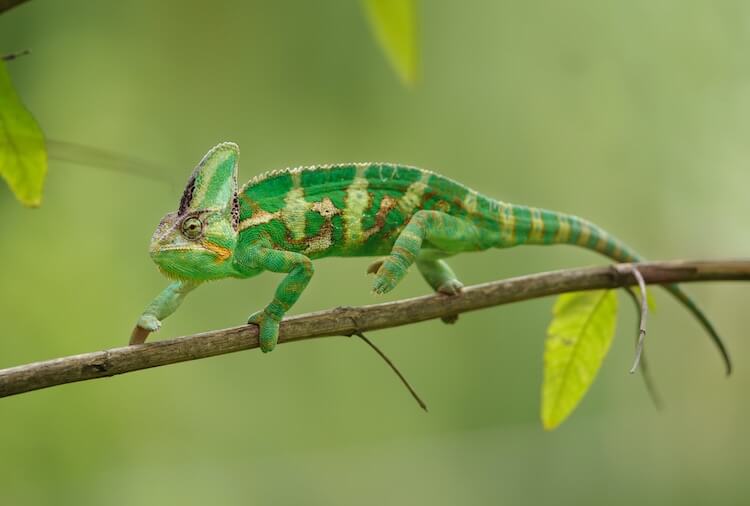
Chameleons can be aggressive and territorial.
If you handle a scared Chameleon you risk him biting you. Larger species like the panther species have a very strong bite.
They will extend their legs and puff out their throat if they perceive you as a threat. They will also become bright in color and hiss at you as a warning. At this point you should walk away from your pet and allow them to relax.
Remember Chameleons are not domesticated pets.
They are not comfortable being handled by humans.
Baby Chameleons should be handled as infrequently as possible. This will help to avoid aggression and health problems.
When approaching a baby you should never make sudden movements. Quick movements seem predatorial to a baby.
If possible it is best to avoid handling altogether.
How To Feed Baby Chameleon
In the wild Baby chameleons eat a variety of insects.
Their diet can include crickets, mealworms, roaches, flies, spiders and more.
Baby chameleons should eat 10 to 20 crickets, roaches or worms every day. These insects should be gut loaded and smaller than the size of your lizard’s head.
Make sure you feed a variety of insects. Do not just feed crickets or worms. Try to include non-toxic butterflies and grasshoppers. You can also feed hawk moths, fruit flies and ants.
Store purchased insects are suitable provided they are prepared properly and gut loaded. In order to gut load the insects feed them fresh fruit and vegetables such as dandelion leaves and potted hibiscus plants.
Once you have prepared the insects use prongs or tweezers to grab them and place them in the enclosure. Your Baby chameleon is a hunter in the wild. They will instinctually know what to do once they see food.
Make sure to feed the gut loaded insects within 24 hours to your lizard.
Once each week dust the insects with a calcium supplement. This supplement should have no vitamin D and little to no phosphorus.
Twice a month feed a multivitamin containing Vitamin A and a low amount of vitamin D3. It is important to provide just the right amount of these vitamins. Too much of a certain vitamin can lead to health issues.
Finally, you need to provide a fresh water source.
In the wild Chameleons obtain their water from droplets on plant leaves or other surfaces. To mimic this you should mist their enclosure. The frequency of misting depends on their species:
- You should spray a Panther chameleon’s enclosure two to four times a day. You can also build a water drip system with a plastic cup.
- For a veiled you should provide a continual one-minute spray once in the evening when the lights are off.
How Fast Do Baby Chameleons Grow?
Monitoring the growth of your baby chameleon is very important.
Growth is a good indicator of proper husbandry.
If a Chameleon is given the proper diet then you can expect a baby to grow one to two inches per month.
Many owners track a young chameleon’s growth each month to make sure they are developing properly. If your Chameleon suddenly stops growing, or starts to lose weight, it can be a sign of stress or improper husbandry.
Below is a growth chart for a baby veiled chameleon. Panther chameleons follow the same growth rate, but are generally larger as adults:
| Age | Size |
|---|---|
| 48 hours | 2 inches |
| 2 weeks | 3 inches |
| 1 month | 5 inches |
| 3 months | 7 inches |
| 8 months | 9 to 14 inches |
| 12 months | 17 to 24 inches (male) 10 to 14 inches (female) |
How To Care For A Baby Chameleon
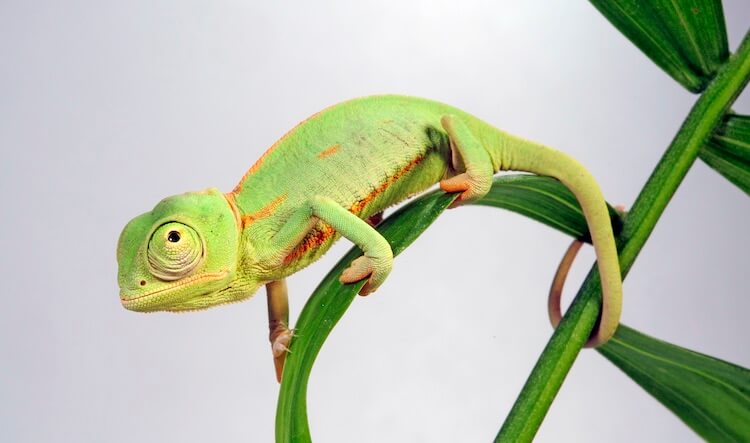
In order to properly take care of a baby chameleon you must set up a proper enclosure and lighting.
The specific setup can vary between species but their requirements are generally the same.
Enclosure Set Up
Chameleons should have a tall plastic-coated wire mesh enclosure placed at eye level.
Baby Chameleons should not be able to see their reflection as this can lead to stress. This means you should not use a glass enclosure.
They are also susceptible to UV ray damage. Because of this you should not place their enclosure near a window or skylight.
Young Chameleons should be housed in an enclosure at least 16 x 16 x 30 inches.
After six months they should be transferred to an adult-sized 60-gallon enclosure.
Plants and Branches
Chameleons are specifically adapted for arboreal habitats. In order to make their habitat suitable to live in you must provide them with décor to climb. To do this you can place vines and branches in their enclosure.
In addition to branches you will need to plant plants in their enclosure too. Bonsai trees, Ivy, Ferns and Orchids are good choices.
Plants will help them feel safe. Providing real plants has been shown to decrease their stress level.
Fake plants can be used, but they should be boiled in hot water for at least 15 minutes to kill possible bacteria.
Regardless of whether you decide to use real or fake plants, they will need to be tall standing and placed throughout the length of the enclosure.
Temperate and Lighting
Baby Chameleons should live in an enclosure that is between 75 to 85°F with 40% to 60% humidity. This temperate can be achieved with proper lighting.
Panther chameleons should be given a 40-watt UVB bulb for 50 hours a week.
Veiled chameleons should have a ceramic reflector dome with a UVA bulb placed six inches above the highest basking perch. The bulb should reach 90 to 95°F during the day.
If the enclosure is still too cold you can also add a 50W ceramic heat emitter.
Substrate
Chameleons spend most of their time up high in their enclosure.
Because of this, unless you plan to use real plants, it is unnecessary to place any substrate at the bottom of their tank.
If you do decide to use real plants in the enclosure then use topsoil without added fertilizer. Harsh chemicals from pesticides and unnatural fertilizer can harm your baby chameleon.
You can also use reptile carpet; however, the loops can snag on the claws of your chameleon.
Why Do Baby Chameleons Die?
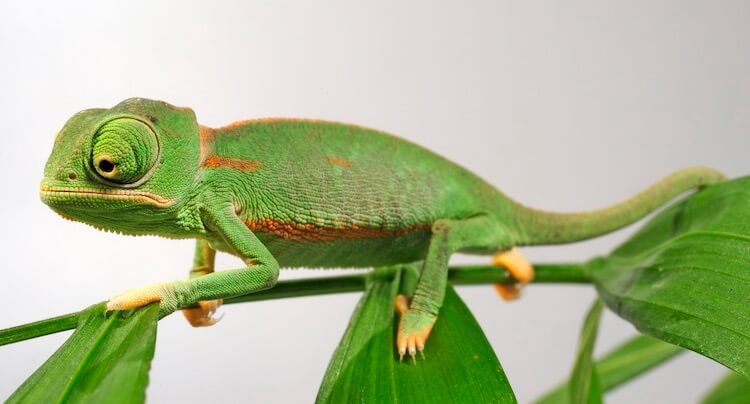
Many Baby Chameleons die in captivity because of stress or poor husbandry.
Babies are not as adaptable to change as other pet lizards. It can be very difficult for first time keepers to provide suitable husbandry to this species.
Continual stress due to improper nutrition, humidity, temperature, hygiene, lighting and disease is extremely common.
A mistake beginners make is thinking that Chameleons are a good pet for children. They are not! Another common mistake is assuming this species likes to be handled. They do not!
Beginners will need to work very hard to provide a proper habitat and diet for this pet.
Feeding store bought insects will not be enough.
You need to provide a variety of insects that are gut loaded. Their diet must also be supplemented as Baby Chameleons need vitamins A and D, calcium and phosphorus.
Without these essential nutrients your Chameleon is at risk of a variety of health problems. Low levels of vitamin A can lead to stunted growth, blindness and reproduction difficulty.
Summary
In order to keep a baby Chameleon healthy you need to do your research beforehand. Research will help you provide proper husbandry and increase the likelihood of keeping a healthy Chameleon.
At a minimum make sure you:
- Provide vitamin A and D3 supplements twice a month.
- Dust their insects with calcium powder once a week.
- Provide a tall mesh enclosure at least 16 x 16 x 30 inches (filled with climbing plants).
- Place their enclosure at eye level.
- Do not handle them.
The amount of effort required to take care of and keep this lizard healthy is a lot. These beautiful reptiles are not suited to everyone.
If you do decide that this species is right for you make sure you buy from a reputable breeder.
Let us know if you have kept a baby chameleon in the comments below.

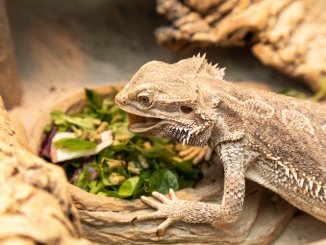
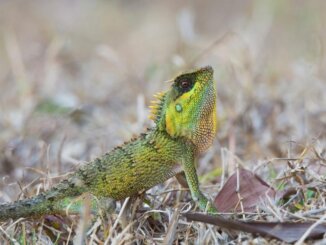
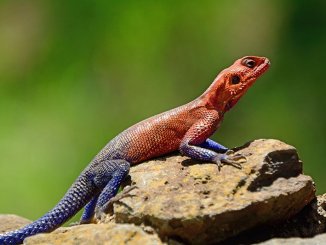

This is a great article. My son, age 12, wants to breed chameleons but is aware that the risk if very high. He has been breeding guinea pigs for over a year and has had other reptiles as pets. Thanks for the info.
I just had 7 baby chameleons hatch out for the first time and really didn’t know everything I should about them thanks for the info I have most of the requirements met but will get the other things needed. They are 24 hours old and seem to be doing good but having a bit of a hard time finding small enough food for them I got some wingless fruit flys but they only had a few do you have any suggestions ?
I did get some small insects from Dubia roaches search for tiny or extra small. Good luck.
Thank you for this article –
I do have a question: is the length of the baby from nose to tip of tail? Or just body length?
And at what point are they considered juvenile?
The length should be measured from nose to tip of tail.
They are considered juvenile around 4-5 months old.
Good day i have a adult Chameleons and have found a baby chameleon resently about 2 to 3 weeks old wil the adult eat the baby if i put them in one enclosure?
While it is unlikely for adults to eat the baby chameleon it will not be good for either the adults or the baby. In general chameleons are antisocial and territorial and having chameleons in the same enclosure causes them stress even if they are not physically violent. In general baby chameleons are more easily stressed so this will definitely not be ideal. The exception is if you have 2 hatchlings then you can house them together as they have not developed their antisocial tendencies yet. The general ruling is that from 4 months old a chameleon should be in its own enclosure. With adult chameleons in the same cage there can be bullying and over competition and this would be very stressful and negative for a baby chameleon.
Baby chameleons also require different living conditions and nutrition requirements than adults so that should be kept in mind as well. Hatchlings thrive better in smaller enclosures with a large amount of foliage. It is not advisable to have a glass enclosure as they get stressed when seeing their own reflection. In addition their habitat should not be close to or under a skylight. They can dehydrate very quickly and changes in their environment further stress them. It is important to remember baby chameleons also require more supplementation than adults.
I just bought a 5 month old baby chameleon. He is the sweetest and actually LOVES to hang out with us.
The first 24 hours with him, was alittle stressful for him and I both. After 48 hours he was acting as any normal chameleon would.
When I brought him home, I fed him 12 crickets & 2 dubia roaches.
Alittle later on, I fed him 12 more crickets. (All shaken With calcium) He ate ALL of his food! & had a very healthy bowl movement with in 32 hours of having him.
I feed my crickets / roaches Romain lettuce, carrots, sweet potatoes, and broccoli. (Small chunks)
I will be looking for some hornworms or some sort of worm that will be high in protein for him and tasty!!
I have visually seen him drink water, and also eat his crickets.
I was alittle nervous at first, but this dude is doing great!
He is the best thing I’ve bought in years, he brings such a huge smile on my face.
He seems like a very happy baby and I hope the best for him and his future.
good my cousion wants one and my name is cat too
Hi.
We saved 2 Chameleons from being dumped and brought them home about
1 month ago.
They are living in our Grenadella bush.
Next thing this morning there are 3 x babies!
We think they are eating the ants and other insects in the Grenadella bush.
What should we feed them?
Regards.
Rosa
Beautiful!
They will mostly eat insects like crickets, ants, worms, roaches and so on. These should always be smaller than the chameleon’s head. Do not just choose one fodder species, but provide a varied diet instead, with monthly vitamin and calcium supplements. Non-toxic butterflies and moths work great too.
Chameleons are wonderfully instinctual hunters, so they will most likely be able to catch prey very early on.
How’ long does it take a newly hatched veiled chameleon to start eating and moving around.
They are born able and usually willing to move and eat. They should be surrounded by a friendly environment though, reason why many people decide to place them in a smaller nursery hours after hatching.
i needed some help learnig about chameleons because my cousin wants one so we need to learn about them i am 11 right now in 4th grade
Hey Cat. I’m very happy you want to learn about these beautiful creatures. What do you need to know? For starters, you can check our article on the 17 best pet Chameleon species